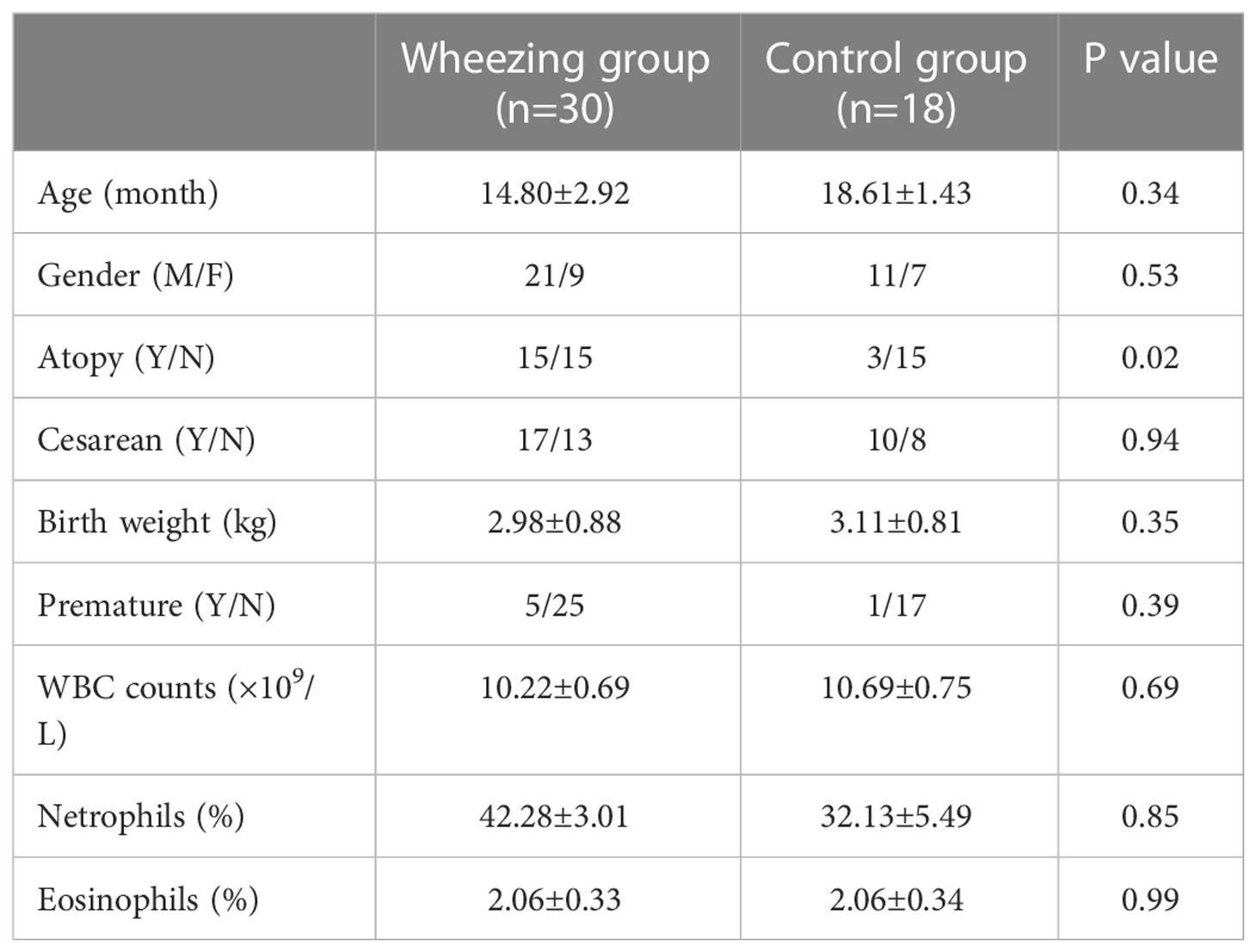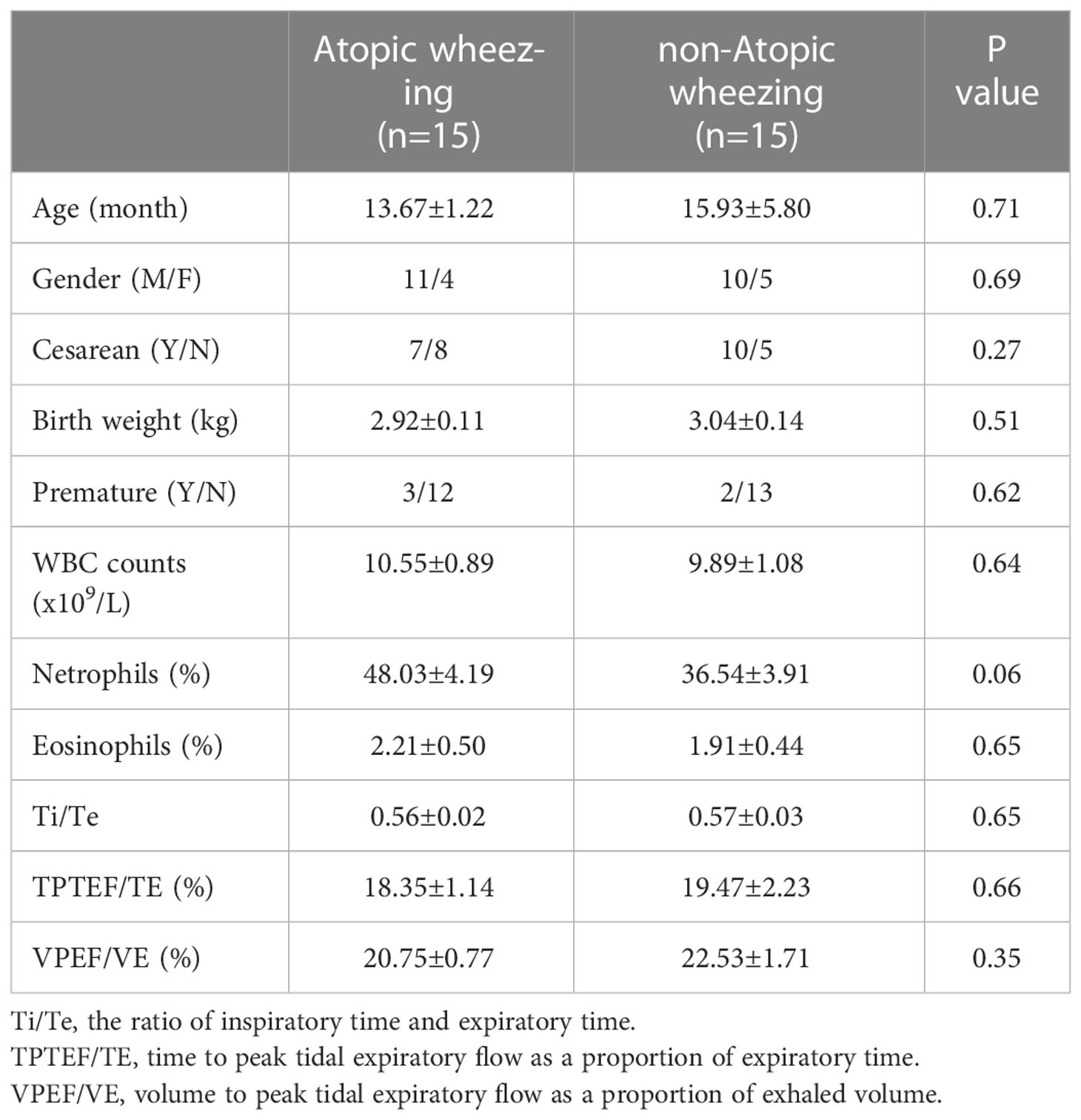- 1Respiratory Department, Chengdu Women’s and Children’s Central Hospital, School of Medicine, University of Electronic Science and Technology of China, Chengdu, China
- 2School of Clinical Medicine, Chongqing Medical and Pharmaceutical College, Chongqing, China
Background: Differences in bronchial microbiota composition have been found to be associated with asthma; however, it is still unclear whether these findings can be applied to recurrent wheezing in infants especially with aeroallergen sensitization.
Objectives: To determine the pathogenesis of atopic wheezing in infants and to identify diagnostic biomarkers, we analyzed the bronchial bacterial microbiota of infants with recurrent wheezing and with or without atopic diseases using a systems biology approach.
Methods: Bacterial communities in bronchoalveolar lavage samples from 15 atopic wheezing infants, 15 non-atopic wheezing infants, and 18 foreign body aspiration control infants were characterized using 16S rRNA gene sequencing. The bacterial composition and community-level functions inferred from between-group differences from sequence profiles were analyzed.
Results: Both α- and β-diversity differed significantly between the groups. Compared to non-atopic wheezing infants, atopic wheezing infants showed a significantly higher abundance in two phyla (Deinococcota and unidentified bacteria) and one genus (Haemophilus) and a significantly lower abundance in one phylum (Actinobacteria). The random forest predictive model of 10 genera based on OTU-based features suggested that airway microbiota has diagnostic value for distinguishing atopic wheezing infants from non-atopic wheezing infants. PICRUSt2 based on KEGG hierarchy (level 3) revealed that atopic wheezing-associated differences in predicted bacterial functions included cytoskeleton proteins, glutamatergic synapses, and porphyrin and chlorophyll metabolism pathways.
Conclusion: The differential candidate biomarkers identified by microbiome analysis in our work may have reference value for the diagnosis of wheezing in infants with atopy. To confirm that, airway microbiome combined with metabolomics analysis should be further investigated in the future.
1 Introduction
Wheezing is a common condition observed in early childhood. It has been reported that approximately 50% of infants experience wheezing before the age of 2 years (Zanobetti et al., 2022), and approximately 1/3 of preschool-age children experience recurrent wheezing (Ünal et al., 2017). Many infants who experience wheezing show allergic sensitization. Based on the asthma prediction index, atopic infants with recurrent wheezing are at high risk for developing asthma (Rodríguez-Martínez et al., 2017; Schmidt et al., 2019). Pediatric asthma is associated with a high incidence of chronic diseases in children. However, the underlying mechanism remains poorly understood.
Pathogenic respiratory infections and allergen sensitization are considered the most common causes of wheezing in infants (Weiss, 2008). Large amounts of microbiota are present throughout the respiratory tract, and the composition of microbiota differs in richness and diversity between individuals (Man et al., 2017), which is the cause of occurrence and development of diseases (Budden et al., 2019). The phenotypic features of asthma, such as airway hyper-responsiveness, asthma control, and transcriptional response to steroids, correlate with bronchial microbial composition (Huang et al., 2015). Airway microbiota may provide predictive value for asthma development in infants (Shah & Bunyavanich, 2021). Most studies of the role of airway microbiota in childhood asthma and wheezing have focused on the upper respiratory tract (Pérez-Losada et al., 2018; Toivonen et al., 2019; McCauley et al., 2019). The influences of the lower respiratory tract bacterial community in wheezing infants, especially in those with atopy, are still being established.
In this study, we aimed to evaluate the differences in microbiota in bronchoalveolar lavage fluid (BAL) between recurrent wheezing and non-wheezing infants using 16S rRNA sequencing technology. Subgroup analyses were used to further confirm the relationships between lower respiratory microbiota and atopy. The study groups did not differ in other confounding factors. Tools for bacterial identification, microbial community biodiversity assessment, and functional predictions were used.
2 Materials and methods
2.1 Subjects and BAL collection
This study was conducted observationally. Infants were recruited from the Chengdu Women’s and Children’s Central Hospital between January 2019 and December 2020. This study was approved by the Ethics Review Board of Chengdu Women’s and Children’s Central Hospital 2016 (22). Written informed consent was obtained from the guardians of all participants. Included in the study were 30 infants who met the following criteria: 1) aged 1–3 years, 2) wheezing occurrence ≥2 times, 3) inhaled corticosteroids and antibiotics not administrated within one week, and 4) diagnosed with wheezing by a physician specializing in pediatric pulmonology. Of the 30 infants, 15 were found to be atopic. Atopy was defined based on skin prick test evidence (wheal diameter >25% induced by histamine) of sensitivity to ≥1 of 12 aeroallergens (allergen skin prick liquids; Aroger Company, Germany). Additionally, 18 children aged 1–3 years who underwent bronchoscopy due to foreign body aspiration within 24 h of sample collection were used as control subjects. Infants > 36 months of age with congenital heart diseases, immunodeficiency, bronchopulmonary dysplasia, cystic fibrosis, or neuromuscular disorders were excluded. Bronchoalveolar lavage (BAL) was performed using a fiberoptic bronchoscope through the airway via a laryngeal mask. BAL samples were collected from wheezing infants and controls, and centrifuged at 14000 × g for 10 min. The pellets were resuspended in 500 μL of phosphate buffered saline (PBS) and stored at -80°C until DNA extraction.
2.2 DNA extraction and 16S rRNA gene sequencing
Total genomic DNA was extracted from the samples using the CTAB/SDS method, and 2% agarose gel electrophoresis was used to detect the purity and concentration of DNA. 16S rRNA gene amplification were performed targeting the V3-V4 hypervariable region (Forward primer 5′- CCTAYGGGRBGCASCAG -3′and Reverse primer 5′- GGACTACNNGGGTATCTAAT -3′). Then, 2% agarose gel electrophoresis was used to detect PCR products. Qualified barcoded DNA amplicons were purified, quantified, and pooled to construct the sequencing library using TruSeq® DNA PCR-Free Sample Preparation Kit (Illumina, California, USA). The constructed library was quantified using Qubit and Q-PCR, and then sequenced on an Illumina NovaSeq 6000 (Illumina, California, USA) platform to generate pair-ended 250 bp reads.
2.3 Data processing
Quality filtering, denoising, and chimera removal of all raw data from sequencing were performed using the Quantitative Insights Into Microbial Ecology (QIIME) platform (Caporaso et al., 2010). In brief, the barcode sequence and PCR amplification primer sequence of each sample’s raw data was split. FLASH (V1.2.7) was used to splice the reads of each sample to obtain the splicing sequence (Raw Tags). And then referring to QIIME’s (V1.9.1) Tag quality control process, the following operations were performed: a) Tags truncated: Raw Tags were truncated from the first low-quality base site where the number of consecutive low-quality bases (the default quality threshold is ≤19) reached the set length (default length value); b) Tags filtered: Tags whose consecutive high-quality base lengths were less than 75% of the Tag length were filtered out; and c) Chimera sequence removed: The tag sequence was compared with the species annotation database to detect the chimera sequence, and the chimera sequence was removed to obtain the final valid data (Effective Tags) for the next step of analysis. Uparse algorithm was performed to cluster the Effective Tags. A 97% sequence homology cut-off was used to define operational taxonomic units (OTUs), which generally approximate the differences in 16S sequences between bacterial species. For clustered OTUs, taxonomic information was annotated using the Silva database (set the threshold to 0.8~1). The main microbiota was identified at the phylum and genus levels. QIIME software (version 1.9.1) was used to calculate alpha and beta diversity, and alpha and beta diversity index between groups was analyzed using R software (wilcox test). FastTree (Price et al., 2009) was used to build the phylogenetic tree. R software (version2.15.3) was employed to perform species abundance cluster heatmap and Metastats analyses of phyla and genera. Linear discriminant (LDA) effect size (LEfSe) analysis was used to determine microbial differences between groups. Random forest modelling was performed using R software (version 3.2.1). Phylogenetic Investigation of Communities by Reconstruction of Unobserved States (PICRUSt2) was adopted to predict microbial functions (Langille et al., 2013; Douglas et al., 2020), and grouping of predicted pathways was performed using the Kyoto Encyclopedia of Genes and Genomes (KEGG) (Kanehisa & Goto, 2000), at hierarchy level 3.
2.4 Statistical analysis
Quantitative data are expressed as mean values with standard deviations (SD), and enumerated data are presented as frequencies. The enumeration data were analyzed by Pearson’s Chi-square test. Student’s t-test or Wilcoxon signed-rank test (agricolae package) was used to compare continuous parametric or non-parametric variables, respectively. The Benjamini-Hochberg method that controls false discovery rate for multiple testing was used. The R statistical software package (R version 2.15.3) was used to perform all statistical analyses and graphics. Statistical significance was set at p<0.05.
3 Results
3.1 Participant characteristics
In total, 30 recurrently wheezing infants (wheezing group, Whz, n=30) were enrolled. Wheezing infants were separated into atopic wheezing (Aw, n=15) and non-atopic wheezing (nAw, n=15) groups. Also enrolled were 18 infants with foreign body aspiration (control group, Con, n=18). Clinical demographics of the participants are presented in Table 1. There were no significant differences in age, sex, Cesarean section status, birth weight, premature birth status, blood WBC count, neutrophil count, or eosinophil proportion between the wheezing and control groups. Atopy differed significantly between the two groups. Considering the effects of atopy on airway microbiota, we conducted a subgroup analysis based on whether wheezing infants were atopic or not to further confirm the relationship between respiratory microbiota and atopy. The detailed characteristics of the Aw and nAw groups are shown in Table 2.
3.2 Microbiota in BAL
3.2.1 Estimation of sequencing depth
After quality control filtering, a total of 2,956,642 high-quality tags were obtained, and the average tags of wheezing and control groups were 60,590 and 63,274, respectively. A total of 4,873 OTUs with at least 97% sequence homology were identified by clustering. Clustered OTUs were annotated with Silva138, and 1,843 (37.82%) OTUs were annotated at the genus level.
The rarefaction curve reflects the rationality of the sequencing data. As shown in Figure1A, the rarefaction curves gradually tended to be flat, indicating a reasonable amount of sequencing data in this study. The rank abundance curve indicates the richness and evenness of the species in the sample. The horizontal width of the curve is related to species richness, whereas the vertical smoothness is related to evenness. As shown in Figure1B, the rank abundance curves indicated that the richness and evenness of each sample group were high. A species accumulation boxplot was used to determine whether the sample size was sufficient. As shown in Figure 1C, the species accumulation boxplot gradually reached the platform stage with increasing sample size, indicating that the sample size was sufficient.

Figure 1 Estimation of sample depth in the Aw, nAw, and Con groups. (A) Rarefaction curves. (B) Rank Abundance curves. (C) Species Accumulation Boxplots. Aw, atopic wheezing group; nAw, non-atopic wheezing group; Con, foreign body aspiration infants as controls.
3.2.2 Alpha-diversity and beta-diversity
Alpha diversity was adopted to analyze the richness (number of taxonomic groups) and evenness (distribution of abundances of the groups) within the microbial communities of the same group. Chao1, observed species, Shannon, and Simpson indexes were evaluated for each sample. The Shannon indices analyzed via Wilcoxon test showed significant differences between the nAw and Con groups. Simpson indices showed significant differences between nAw and Con and between Aw and nAw (Figure 2).
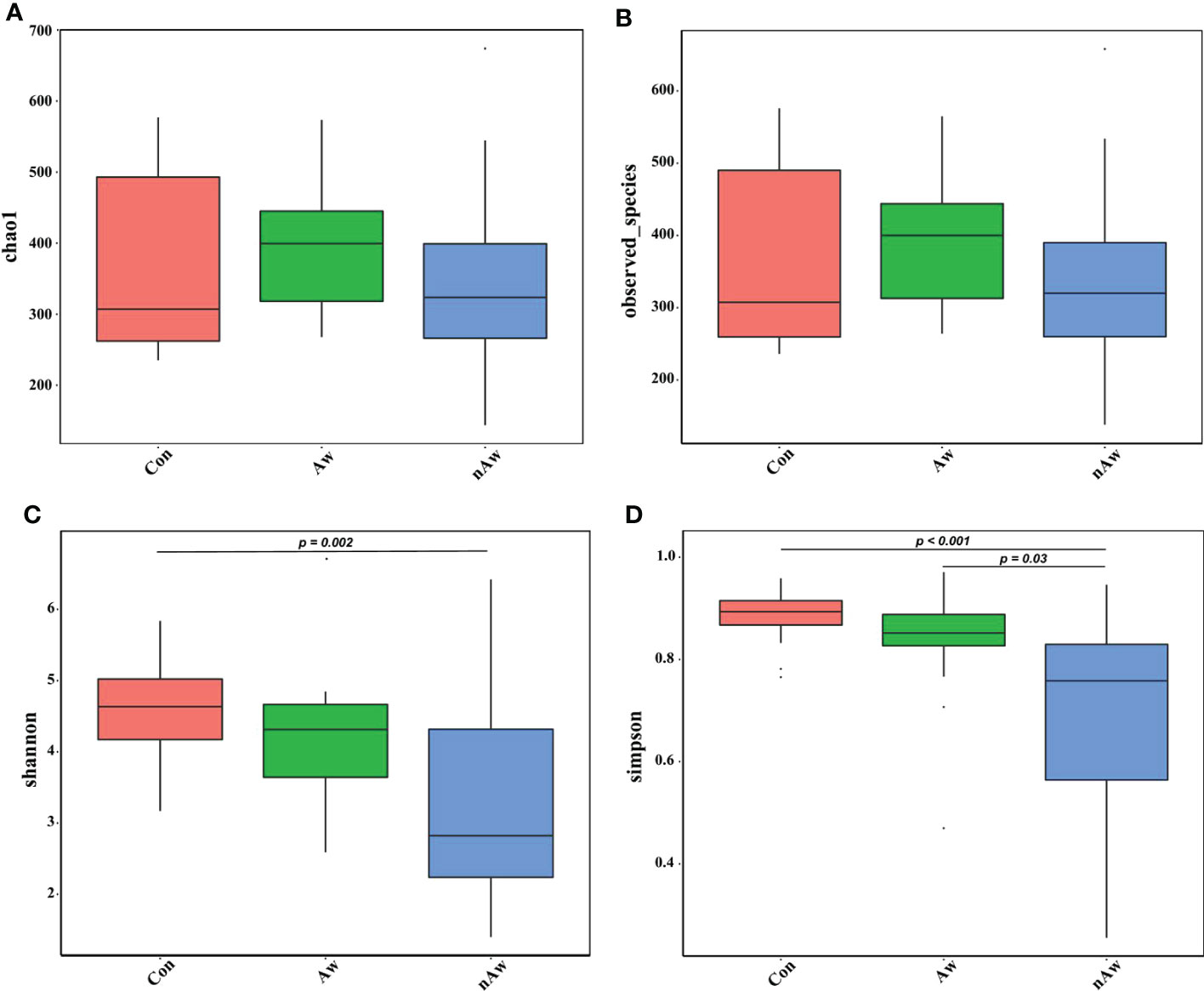
Figure 2 Alpha-diversity analysis of microbiome in BAL. (A) Chao1 index statistics. (B) Observed_species index statistics. (C) Shannon index statistics. (D) Simpson index statistics. Wilcox test was used. Aw, atopic wheezing group; nAw, non-atopic wheezing group; Con, foreign body aspiration infants as controls.
The beta diversity index based on the weighted Unifrac and Bray_Curtis metrics showed significant differences among the three groups (Figures 3A, B). The Wilcoxon test was used to calculate differences. Principal coordinate analysis (PCoA) plots based on weighted analysis and principal component analysis (PCA) were used for data visualization (Figures 3C, D).
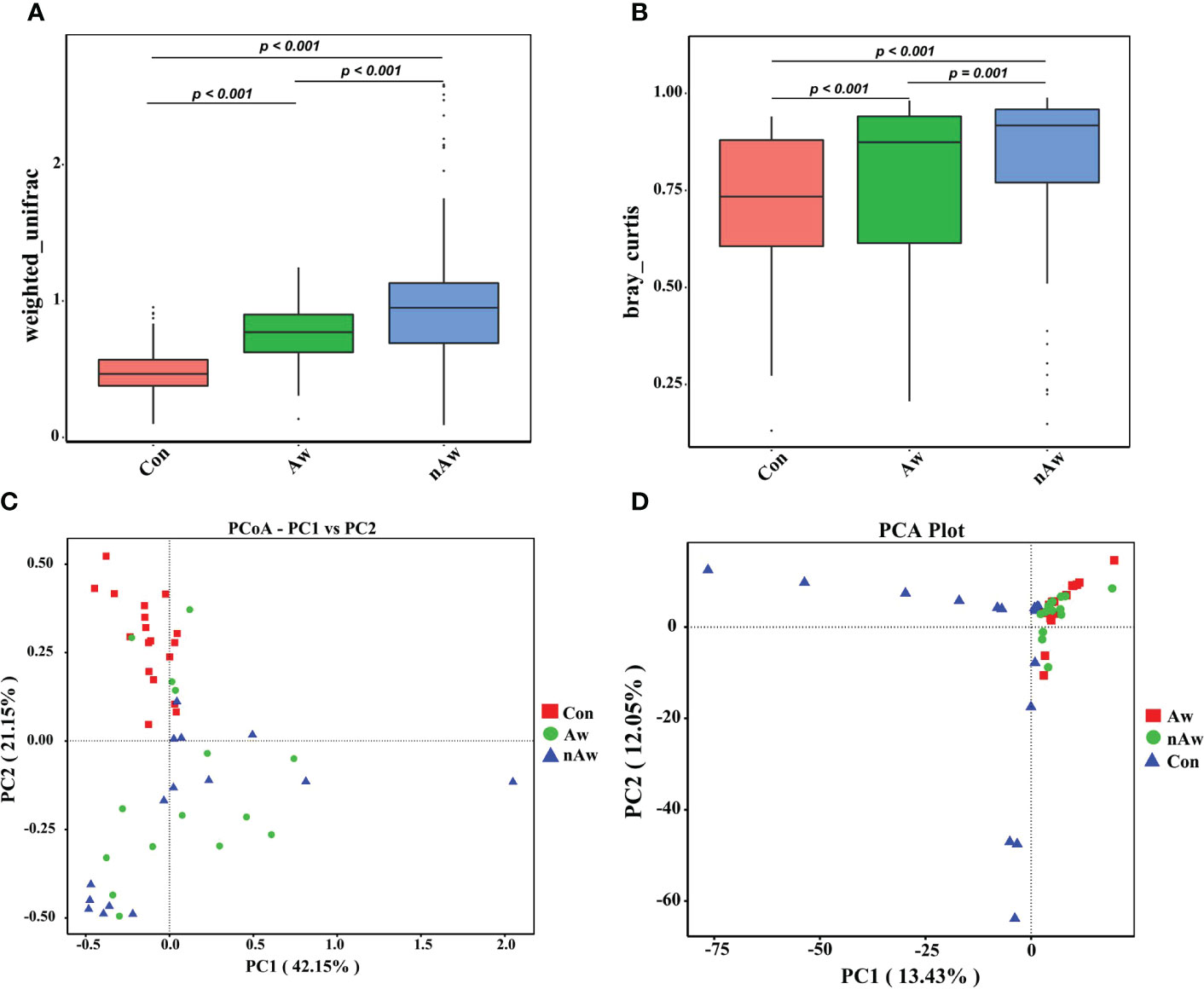
Figure 3 Beta-diversity analysis of microbiome in BAL. (A) Beta diversity index based on Weighted Unifrac, (B) Beta diversity index based on Bray_Curtis, (C) Display of Principal Co-ordinates Analysis (PCoA) plots of the samples in two-dimension based on weighted unifrac (PC1 = 42.15%, PC2 = 21.15%), (D) Display of Principal Component Analysis (PCA) of the samples in two-dimension (PC1 = 13.43%, PC2 = 12.05%). Wilcox test was used. Aw, atopic wheezing group; nAw, non-atopic wheezing group; Con, foreign body aspiration infants as controls.
3.3 Distribution of microbial taxonomic composition in wheezing infants
To visually examine the similarities and differences in community composition of each group at the genus level, abundance information of the top 35 genera was obtained for clustering via the maximal ranking method, and a heat map was generated from the species annotation and abundance information. Cluster analysis via heatmap showed that the bacterial composition at the genus level differed among the three groups (Figure 4A). In order to study the phylogenetic relationships of species at the genus level, representative sequences of the top 50 genera were obtained by multiple sequence alignment, and phylogenetic trees were constructed based on the representative sequences. (Figure 4B).
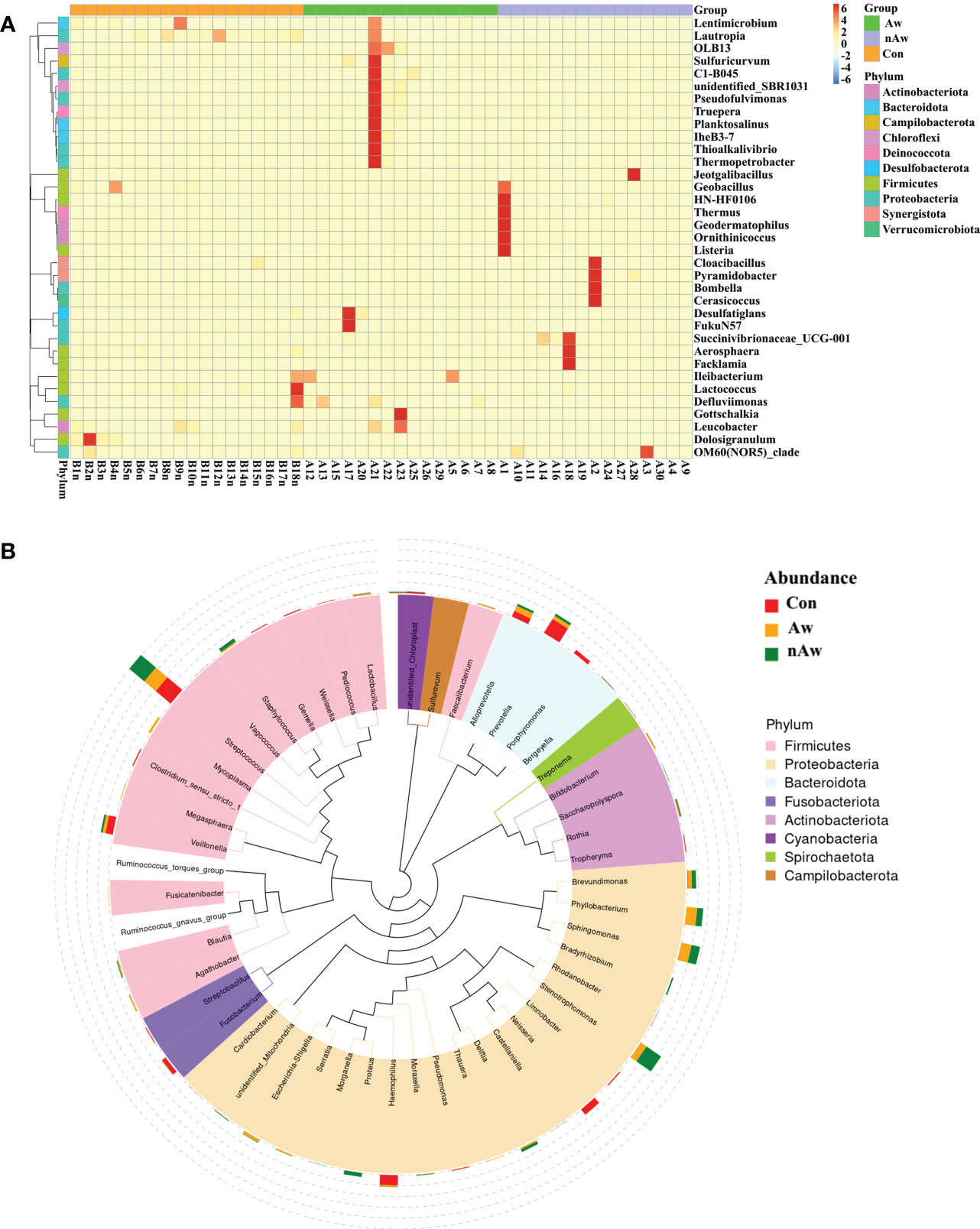
Figure 4 Heatmap and Phylogenetic tree at genus level. (A) Cluster heatmap. The plot depicts the relative abundance of each genus (x-axis) within each sample (y-axis). (B) Phylogenetic tree. The branch and fan colors indicate their corresponding gates, and stacked histograms outside the fan rings indicate the abundance distribution. Aw, atopic wheezing group; nAw, non-atopic wheezing group; Con, foreign body aspiration infants as controls.
3.4 The distribution of taxa at phylum and genus levels in wheezing infants
Based on the species annotation results, the top 10 species with the highest abundance in the phylum and genus levels were selected from the atopic and non-atopic wheezing groups, and a relative abundance histogram was generated. Proteobacteria, Firmicutes, and Bacteroidetes were the most abundant phyla in the airway microbiota (Figure 5A), whereas Streptococcus, Stenotrophomonas, Sphingomonas, and Phyllobacterium were the dominant genera in both groups (Figure 5B). Deinococcota and unidentified bacteria phyla were more abundant in Aw (p<0.05 and p<0.01, respectively). Figure 5C), while Actinobacteria was more abundant in nAw (p<0.05, Figure 5C). At the genus level, Haemophilus was significantly enriched in Aw compared with nAw (p<0.05, Figure 5D).
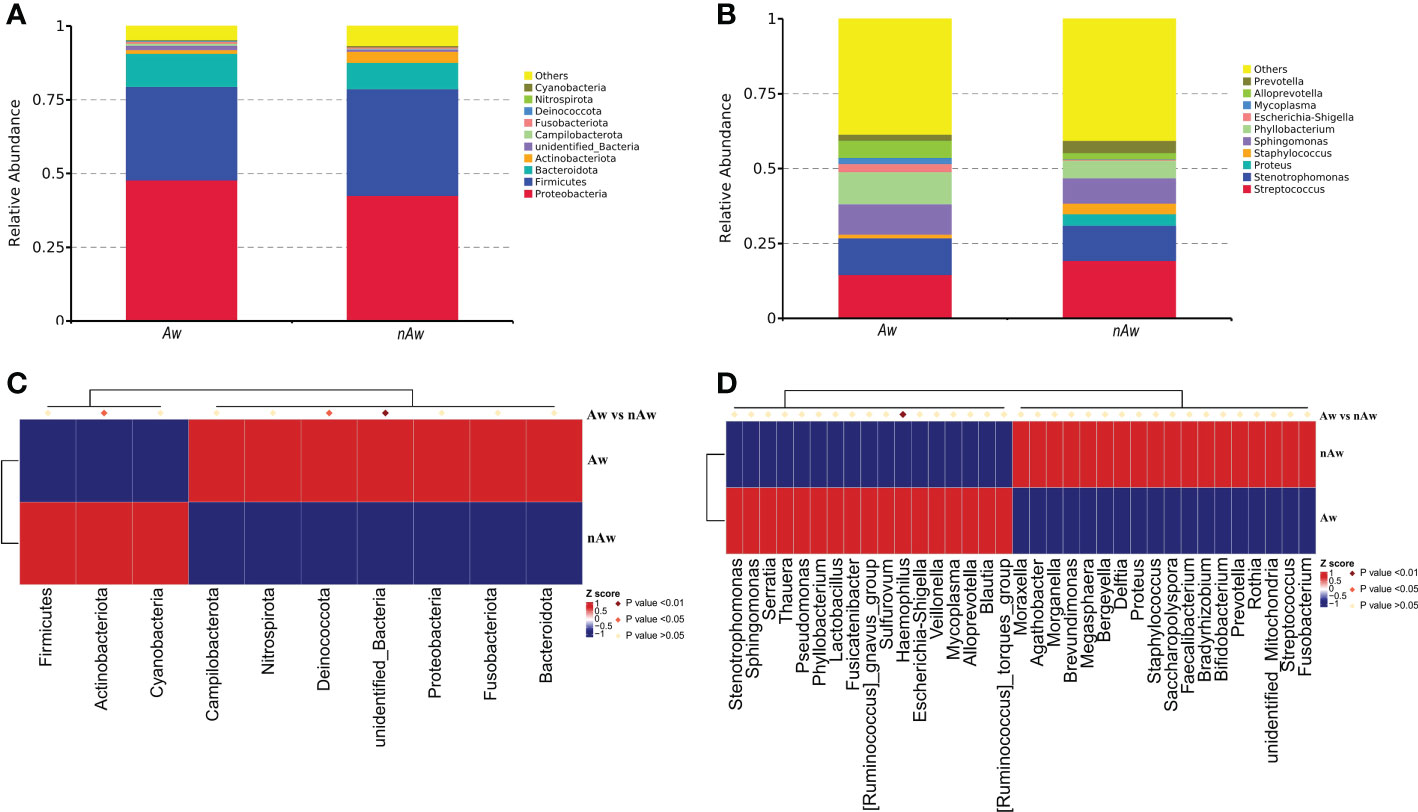
Figure 5 The distribution of taxa in phylum and genus levels of Aw and nAw. (A) composition of microbiome at the phylum level. (B) composition of microbiome at the genus level. (C) the statistical results of top 10 phylum. (D) the statistical results of top 35 genus. Aw, atopic wheezing group; nAw, non-atopic wheezing group.
3.5 Linear discriminant analysis in wheezing infants
To identify differences in bacterial taxa composition between Aw and nAw, LEfSe analysis was performed. Based on LDA scores of > 3.0, two phyla, three classes, five orders, seven families, eight genera, and one species were highly abundant in Aw, whereas one genus and three species were significantly more abundant in nAw. Bacteroidales, Bacteroidia, and Bacteroidota were significantly abundant in Aw, whereas Neorhizobium was more abundant in nAw (p<0.05, Figure 6).
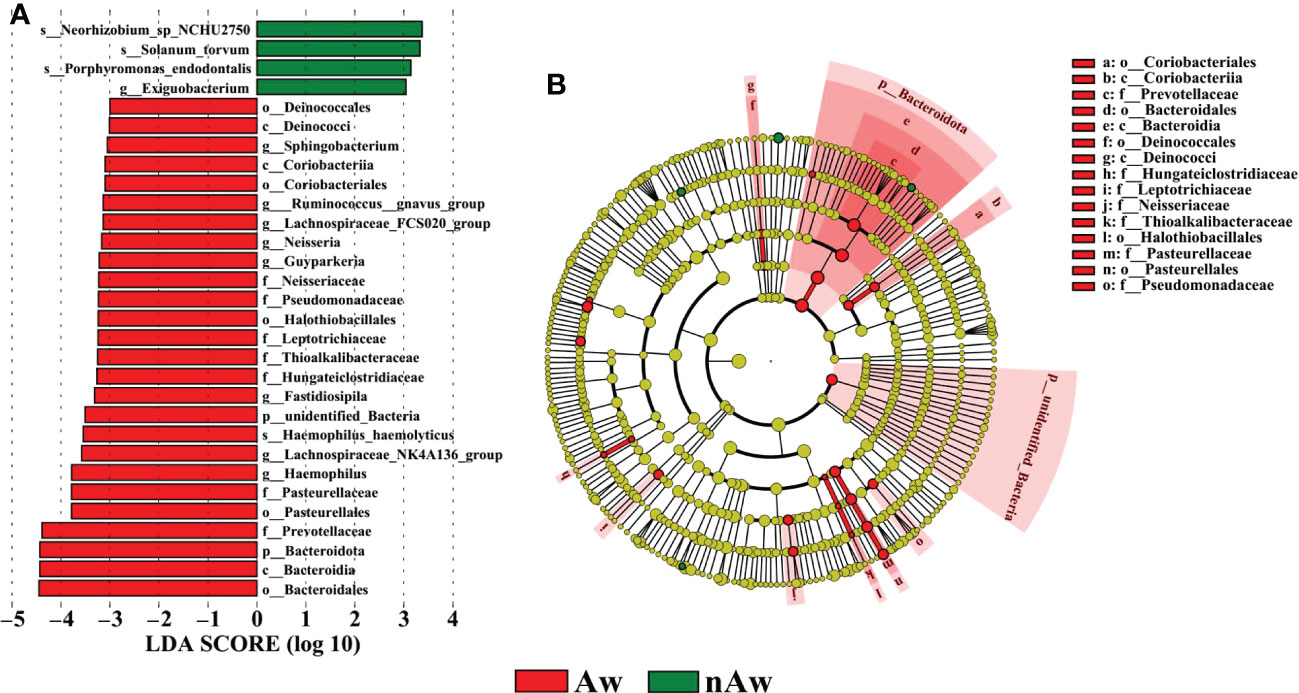
Figure 6 Linear discriminant analysis (LDA). (A) Histogram of the LDA scores (>3) computed for bacterial taxa differentially abundant between Aw and nAw. The size of each node represents the LDA score. (B) Bacterial taxa that were differentially abundant in the group visualized using a cladogram. The size of each node represents their relative abundance. Significantly discriminant taxon nodes are colored and branch areas are shaded according to the highest-ranked variety for that taxon. Aw, atopic wheezing group; nAw, non-atopic wheezing group.
3.6 Predictive modeling of the airway microbial profile in wheezing infants
3.6.1 Random forest
In our analysis, a random forest prediction model of ten genera was constructed using OTU-based features. In random forest, the sample dataset is divided into two parts at a ratio of 75:25, using 75% of the data to train the machine learning algorithm, and the remaining 25% for independent testing. Then, significant genera were selected using mean decrease in accuracy (Figure 7A). 10-fold cross-validation was conducted for the model, and receiver operating characteristic (ROC) curves were used to score the predictive power. The area under the curve (AUC) was 0.8846 (95% CI: 0.745−1.000) (Figure 7B), which indicated the airway microbiota diagnostic potential in wheezing infants. We observed that in the model, the 10 significant genera were Parabacteroides, Dolosigranulum, Neisseria, Christensenellaceae_R_7_group, Marvinbryantia, Massilia, Lachnospiraceae_UCG_010, unidentified_ Lachnospiraceae, Ruminococcusgnavus_group_Ruminococcusgnavus_group, and Campylobacter. These may serve as biomarkers to identify infants most likely to have atopic wheezing.
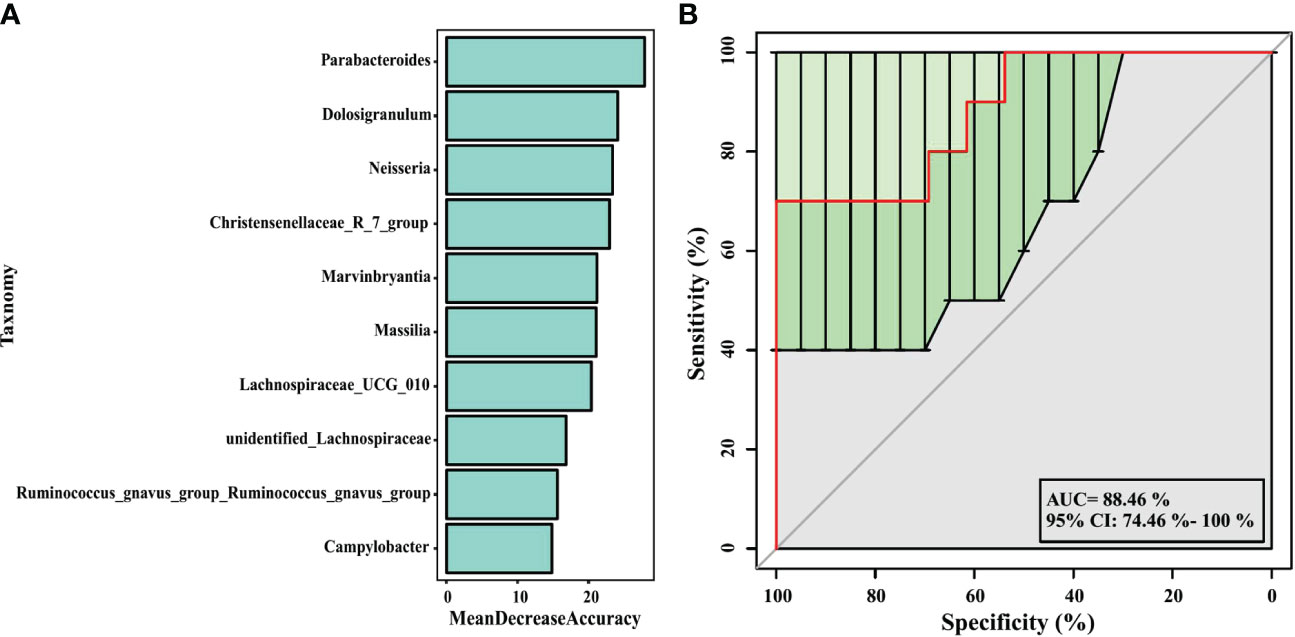
Figure 7 Prediction model of the airway microbiota for atopic wheezing status based on the genus-level relative abundances using random forests. (A) variable importance ranking chart, Mean Decrease Accuracy measures the degree to which the prediction accuracy of a random forest decreases by changing the value of a variable to a random number. A higher value indicates that the variable is more important. (B) ROC curve of the atopic wheezing model using 10 discriminatory genus. AUC, the area under the curve; ROC, receiver operating characteristic.
3.6.2 Functional prediction
PICRUSt2, a method to predict the functional potential of bacterial community using 16S rRNA amplicon data based on KEGG database, was used to evaluate the functional differences of microbiomes between Aw and nAw. 294 metabolic pathways were discovered in all samples (N = 294 pathways), and three metabolic pathways, namely glutamatergic synapse, cytoskeleton proteins, and porphyrin and chlorophyll metabolism, were significantly different between the two groups by statistical analysis metagenomic profiles (STAMP) test (Figure 8).
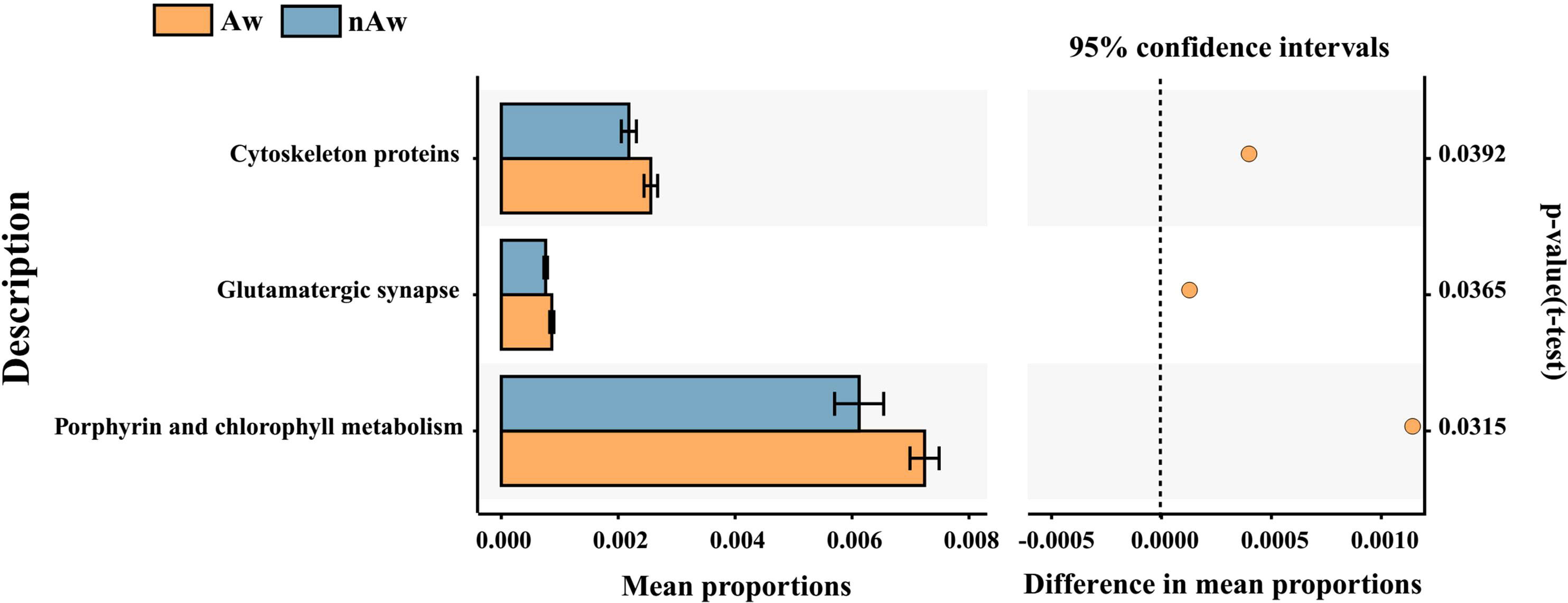
Figure 8 Predicted functional. Predicted functional differences between Aw and nAw microbiomes. A total of three metabolic pathways differed significantly between Aw and nAw infants. Pathways that were more abundant in Aw are on the positive side (orange circle with 95% confidence interval). Mean proportions are shown in stacks for Aw (orange) and nAw (blue). Differences in mean proportions: mean proportion in Aw minus mean proportions in nAw. Tests were conducted at KEGG hierarchical level 3, which included 294 pathways present in all samples. Aw, atopic wheezing group; nAw, non-atopic wheezing group.
4 Discussion
In recent years, human lifestyles have changed to be largely indoors, and the number of infants exposed to environmental microbes has decreased. However, the annual incidence of allergic and wheezing diseases has increased. Atopic infants with recurrent wheezing are more likely to develop asthma, but the reason for this is unclear. The airway microbiota has been proposed to be linked to various pediatric respiratory diseases. Studies have reported that specific patterns of respiratory microbial colonization are associated with the severity of viral respiratory infections (Alba et al., 2021) and the phenotypic features of asthma (Durack et al., 2017a). Therefore, in-depth studies of the lower airway microbiota and its functional characteristics in infants with recurrent wheezing, especially atopic wheezing, are necessary. In this study, we collected BAL specimens from infants with recurrent wheezing and foreign body controls. Through high-throughput 16S rRNA sequencing, differences in the diversity, richness, composition, and function of the lower airway microbiome were compared. Our findings show diversity, compositional, and predicted functional differences in the bronchial bacterial microbiota between Aw infants and nAw infants.
The functional abundance of the microbiome depends on the individual and interactions between the environment and microbial community (Orland et al., 2019). Airway microbiota may be involved in the maturation and maintenance of respiratory physiology and immune homeostasis (Man et al., 2017). We found that the microbiota in BAL from both atopic and non-atopic wheezing infants was mainly composed of Proteobacteria, Firmicutes, and Bacteroidetes at the phylum level, and Streptococcus, Stenotrophomonas, Sphingomonas, and Phyllobacterium at the genus level. It is reported that, compared to healthy controls, asthmatic patients have higher microbiome diversity and altered composition, more Proteobacteria, and fewer Bacteroidetes (Sverrild et al., 2017). Another study (Hilty et al., 2010) found that the composition of the Proteobacteria phylum was associated with airway disease in both asthmatic and chronic obstructive pulmonary disease (COPD) patients. Currently, the genus Stenotrophomonas consists of four species, of which only one (S. maltophilia) is known to cause human infection (Coenye et al., 2004). In recent years, the human pathogen S. maltophilia has spread globally, and does not usually infect healthy hosts, but it has been found to be associated with high morbidity and mortality in severely immunocompromised individuals (An & Berg, 2018). Berdah et al. reported that S. maltophilia appeared to be a marker for cystic fibrosis lung disease severity (Berdah et al., 2018). Patients with asthma treated with inhaled corticosteroids had a higher abundance of Sphingomonas than patients without (Huang et al., 2021). A study of swine lung microbiota and their potential relationship with lung lesions found that Sphingobium and Phyllobacterium were the most abundant microbes in severely diseased lungs (Huang et al., 2019).
When bacterial taxa composition differences were compared, the results showed that the number of Haemophilus was significantly increased in atopic wheezing infants. This result is consistent with the findings of other authors. Durack et al. reported that haemophilus were uniquely enriched in adult asthmatic subjects, and the baseline compositional of the bacterial microbiota were linked to steroid-responsiveness (Durack et al., 2017a). The higher abundance of Haemophilus in the respiratory microbiota may regulate airway inflammation during severe RSV bronchiolitis in infancy, potentially contributing to the subsequent development of recurrent wheezing in childhood (Zhang et al., 2020).Current evidence suggests that the presence of specific microbes in the airways, particularly Streptococcus, Haemophilus, and Moresila, may shape local immune responses and alter the severity and presentation of airway inflammation (Ver Heul et al., 2019). Microbiomes dominated by Haemophilus have been shown to be associated with severe diseases and frequent recurrences (Richardson et al., 2019). Microbiomes in sputum are associated with the clinical and inflammatory phenotypes of COPD. Decreased microbiome diversity due to Haemophilus dominance is associated with increased neutrophil-associated protein profiles and an increased risk of mortality (Dicker et al., 2021). On the contrary, Wu et al. reported different results. They found that persistent wheezing infants with wheezing history had a lower abundance of Haemophilus compared with those without wheezing history (Wu et al., 2021). Differential results varied between existing studies, which may be due to heterogeneity between studies, such as sample size, study area, patient age, and clinical features.
Random forest models can be used to screen potential novel biomarkers. In this study, we constructed a random forest predictive model for the top 10 genera based on OTU-based features. The AUC was > 0.6, indicating that airway microbiomes have diagnostic value for distinguishing atopic wheezing infants from non-atopic wheezing infants. This indicates that the distinguishing bacteria can be used as candidate biomarkers. Among the top ten genera, Parabacteroides was the most significant marker for predicting atopic wheezing. Parabacteroides is a gram-negative anaerobic bacterium. At present, there are 15 species in the genus, of which 10 are “validly named” and 5 are “not validly named” according to the list of prokaryotic names with Standing in Nomenclature. The genus Parabacteroides is associated with reports of both beneficial and pathogenic effects on human health (Ezeji et al., 2021). Parabacteroides goldsteinii ameliorates COPD. Lipopolysaccharides extracted from Parabacteroides goldsteinii have anti-inflammatory function and significantly improve COPD as an antagonist of the toll-like receptor 4 signaling pathway (Lai et al., 2022).
The microbiota may contribute to disease susceptibility via metabolite-mediated immunological progression (Segal et al., 2017). PICRUSt2 based on KEGG hierarchy (level 3) revealed that atopic wheezing-associated differences in predicted bacterial functions included cytoskeleton proteins, glutamatergic synapses, and porphyrin and chlorophyll metabolism pathways. This indicated that functional differences in respiratory microbiota existed between the Aw and nAw groups. It has been reported that the cytoskeleton plays a key regulatory role in maintaining the cell barrier. The increased permeability of epithelial and endothelial cells is mainly due to the reorganization of cytoskeletal junction complexes. Proinflammatory mediators, such as cytokines, can induce cytoskeleton rearrangement, leading to inflammation-dependent intestinal barrier function defects (López-Posadas et al., 2017). Secreted gastrointestinal microbial factors induce EMT-like properties in tumor cells, and thus promote disease progression by affecting cytoskeletal reorganization (Henstra et al., 2021). Lung bacteria contain greater amounts of cytoskeletal proteins and have greater function in energy production and conversion compared to intestinal bacteria (Liu et al., 2020a). Previous studies have revealed that fecal microbiota transplantation might be an efficient way to improve the physiology and behavior of chickens by increasing the functional capabilities of microbial communities in glutamatergic synapse-related pathways (Yan et al., 2021). Porphyrin and chlorophyll metabolism were significantly enriched in allergic rhinitis patients (Liu et al., 2020b), but were reduced in children with chronic pancreatitis when predictive metagenomic functional analysis was conducted (Wang et al., 2020). So far, there are only limited reports about this bacterial functional pathway in humans, and its role in wheezing and asthmatic children remains to be further elucidated.
This study has some limitations. The sample size was on the smaller side; therefore, a larger sample size is required to confirm the accuracy of our results. In addition, for ethical reasons, healthy infants could not be used as a control group, which may affect the validity of the results. The study mainly focused on bacterial abundance rather than viral and fungal studies. Viral respiratory infections are proposed to be the main cause of recurrent wheezing in infants (Parisi et al., 2022). Future studies utilizing systems biology approaches to assess bacterial, viral, and fungal microbiomes would help us better understand host-microbiota interactions and their significance in recurrent wheezing in infants. Finally, this was a cross-sectional observational study, and further longitudinal and unbiased studies of airway microbiota analysis will be useful for understanding the mechanisms underlying recurrent wheezing in infants.
5 Conclusion
In conclusion, the differential candidate biomarkers identified by microbiome analysis in our work may have reference value for the diagnosis of wheezing in infants with atopy. To confirm that, airway microbiome combined with metabolomics analysis should be further investigated in the future.
Data availability statement
The data presented in the study are deposited in the Mendeley repository, accession link: dx.doi.org/10.17632/d4kb7zy533.1.
Ethics statement
This study was approved by the Ethics Review Board of Chengdu Women’s and Children’s Central Hospital 2016 (22). Written informed consent was obtained from the guardians of all participants.
Author contributions
WT and LZ came up with the original idea. WT, LZ, and TA performed the BAL collection and 16S rRNA gene sequencing. WT, WX, CX, and YF carried out the data analysis. WT wrote the first version of the manuscript. SC, ZC, JY, and YP made corresponding contributions to the paper. All listed authors made substantial, direct, and intellectual contributions to the work and approved its publication.
Funding
This work was supported by the Chengdu Municipal Health Commission of Sichuan Province of China (grant number 2022295) and by the Health Commission of Sichuan Province of China (grant number 16PJ067).
Acknowledgments
We would like to thank all the subjects and their guardians who agreed to participate in this study.
Conflict of interest
The authors declare that the research was conducted in the absence of any commercial or financial relationships that could be construed as a potential conflict of interest.
Publisher’s note
All claims expressed in this article are solely those of the authors and do not necessarily represent those of their affiliated organizations, or those of the publisher, the editors and the reviewers. Any product that may be evaluated in this article, or claim that may be made by its manufacturer, is not guaranteed or endorsed by the publisher.
References
Alba, C., Aparicio, M., González-Martínez, F., González-Sánchez, M. I., Pérez-Moreno, J., Toledo Del Castillo, B., et al. (2021). Nasal and fecal microbiota and immunoprofiling of infants with and without RSV bronchiolitis. Front. Microbiol. 12. doi: 10.3389/fmicb.2021.667832
An, S. Q., Berg, G. (2018). Stenotrophomonas maltophilia. Trends Microbiol. 26 (7), 637–638. doi: 10.1016/j.tim.2018.04.006
Berdah, L., Taytard, J., Leyronnas, S., Clement, A., Boelle, P. Y., Corvol, H. (2018). Stenotrophomonas maltophilia: A marker of lung disease severity. Pediatr. Pulmonol. 53 (4), 426–430. doi: 10.1002/ppul.23943
Budden, K. F., Shukla, S. D., Rehman, S. F., Bowerman, K. L., Keely, S., Hugenholtz, P., et al. (2019). Functional effects of the microbiota in chronic respiratory disease. Lancet Respir. Med. 7 (10), 907–920. doi: 10.1016/s2213-2600(18)30510-1
Caporaso, J. G., Kuczynski, J., Stombaugh, J., Bittinger, K., Bushman, F. D., Costello, E. K., et al. (2010). QIIME allows analysis of high-throughput community sequencing data. Nat. Methods 7 (5), 335–336. doi: 10.1038/nmeth.f.303
Coenye, T., Vanlaere, E., Falsen, E., Vandamme, P. (2004). Stenotrophomonas africana drancourt et al. 1997 is a later synonym of stenotrophomonas maltophilia (Hugh 1981) palleroni and Bradbury 1993. Int. J. Syst. Evol. Microbiol. 54 (Pt 4), 1235–1237. doi: 10.1099/ijs.0.63093-0
Dicker, A. J., Huang, J. T. J., Lonergan, M., Keir, H. R., Fong, C. J., Tan, B., et al. (2021). The sputum microbiome, airway inflammation, and mortality in chronic obstructive pulmonary disease. J. Allergy Clin. Immunol. 147 (1), 158–167. doi: 10.1016/j.jaci.2020.02.040
Douglas, G. M., Maffei, V. J., Zaneveld, J. R., Yurgel, S. N., Brown, J. R., Taylor, C. M., et al. (2020). PICRUSt2 for prediction of metagenome functions. Nat. Biotechnol. 38 (6), 685–688. doi: 10.1038/s41587-020-0548-6
Durack, J., Lynch, S. V., Nariya, S., Bhakta, N. R., Beigelman, A., Castro, M., et al. (2017a). Features of the bronchial bacterial microbiome associated with atopy, asthma, and responsiveness to inhaled corticosteroid treatment. J. Allergy Clin. Immunol. 140 (1), 63–75. doi: 10.1016/j.jaci.2016.08.055
Ezeji, J. C., Sarikonda, D. K., Hopperton, A., Erkkila, H. L., Cohen, D. E., Martinez, S. P., et al. (2021). Parabacteroides distasonis: intriguing aerotolerant gut anaerobe with emerging antimicrobial resistance and pathogenic and probiotic roles in human health. Gut Microbes 13 (1), 1922241. doi: 10.1080/19490976.2021.1922241
Henstra, C., van Praagh, J., Olinga, P., Nagelkerke, A. (2021). The gastrointestinal microbiota in colorectal cancer cell migration and invasion. Clin. Exp. Metastasis. 38 (6), 495–510. doi: 10.1007/s10585-021-10130-x
Hilty, M., Burke, C., Pedro, H., Cardenas, P., Bush, A., Bossley, C., et al. (2010). Disordered microbial communities in asthmatic airways. PloS One 5 (1), e8578. doi: 10.1371/journal.pone.0008578
Huang, Y. J., Nariya, S., Harris, J. M., Lynch, S. V., Choy, D. F., Arron, J. R., et al. (2015). The airway microbiome in patients with severe asthma: Associations with disease features and severity. J. Allergy Clin. Immunol. 136 (4), 874–884. doi: 10.1016/j.jaci.2015.05.044
Huang, C., Yu, Y., Du, W., Liu, Y., Dai, R., Wang, P., et al. (2021). Insights into gut microbiome and its functional pathways in asthma patients through high-throughput sequencing. Future Microbiol. 16, 421–438. doi: 10.2217/fmb-2020-0101
Huang, T., Zhang, M., Tong, X., Chen, J., Yan, G., Fang, S., et al. (2019). Microbial communities in swine lungs and their association with lung lesions. Microb. Biotechnol. 12 (2), 289–304. doi: 10.1111/1751-7915.13353
Kanehisa, M., Goto, S. (2000). KEGG: kyoto encyclopedia of genes and genomes. Nucleic Acids Res. 28 (1), 27–30. doi: 10.1093/nar/28.1.27
Lai, H. C., Lin, T. L., Chen, T. W., Kuo, Y. L., Chang, C. J., Wu, T. R., et al. (2022). Gut microbiota modulates COPD pathogenesis: role of anti-inflammatory parabacteroides goldsteinii lipopolysaccharide. Gut. 71 (2), 309–321. doi: 10.1136/gutjnl-2020-322599
Langille, M. G., Zaneveld, J., Caporaso, J. G., McDonald, D., Knights, D., Reyes, J. A., et al. (2013). Predictive functional profiling of microbial communities using 16S rRNA marker gene sequences. Nat. Biotechnol. 31 (9), 814–821. doi: 10.1038/nbt.2676
Liu, X., Tao, J., Li, J., Cao, X., Li, Y., Gao, X., et al. (2020b). Dysbiosis of fecal microbiota in allergic rhinitis patients. Am. J. Rhinol. Allergy 34 (5), 650–660. doi: 10.1177/1945892420920477
Liu, T. H., Zhang, C. Y., Din, A. U., Li, N., Wang, Q., Yu, J. Z., et al. (2020a). Bacterial association and comparison between lung and intestine in rats. Biosci. Rep. 40 (4), bsr20191570. doi: 10.1042/bsr20191570
López-Posadas, R., Stürzl, M., Atreya, I., Neurath, M. F., Britzen-Laurent, N. (2017). Interplay of GTPases and cytoskeleton in cellular barrier defects during gut inflammation. Front. Immunol. 8. doi: 10.3389/fimmu.2017.01240
Man, W. H., de Steenhuijsen Piters, W. A., Bogaert, D. (2017). The microbiota of the respiratory tract: gatekeeper to respiratory health. Nat. Rev. Microbiol. 15 (5), 259–270. doi: 10.1038/nrmicro.2017.14
McCauley, K., Durack, J., Valladares, R., Fadrosh, D. W., Lin, D. L., Calatroni, A., et al. (2019). Distinct nasal airway bacterial microbiotas differentially relate to exacerbation in pediatric patients with asthma. J. Allergy Clin. Immunol. 144 (5), 1187–1197. doi: 10.1016/j.jaci.2019.05.035
Orland, C., Emilson, E. J. S., Basiliko, N., Mykytczuk, N. C. S., Gunn, J. M., Tanentzap, A. J. (2019). Microbiome functioning depends on individual and interactive effects of the environment and community structure. Isme J. 13 (1), 1–11. doi: 10.1038/s41396-018-0230-x
Parisi, G. F., Manti, S., Papale, M., Giallongo, A., Indolfi, C., Miraglia Del Giudice, M., et al. (2022). Addition of a nutraceutical to montelukast or inhaled steroid in the treatment of wheezing during COVID-19 pandemic: A multicenter, open-label, randomized controlled trial. Acta Biomed. 93 (2), e2022156. doi: 10.23750/abm.v93i2.11958
Pérez-Losada, M., Authelet, K. J., Hoptay, C. E., Kwak, C., Crandall, K. A., Freishtat, R. J. (2018). Pediatric asthma comprises different phenotypic clusters with unique nasal microbiotas. Microbiome. 6 (1), 179. doi: 10.1186/s40168-018-0564-7
Price, M. N., Dehal, P. S., Arkin, A. P. (2009). FastTree: computing large minimum evolution trees with profiles instead of a distance matrix. Mol. Biol. Evol. 26 (7), 1641–1650. doi: 10.1093/molbev/msp077
Richardson, H., Dicker, A. J., Barclay, H., Chalmers, J. D. (2019). The microbiome in bronchiectasis. Eur. Respir. Rev. 28 (153), 190048. doi: 10.1183/16000617.0048-2019
Rodríguez-Martínez, C. E., Sossa-Briceño, M. P., Castro-Rodriguez, J. A. (2017). Factors predicting persistence of early wheezing through childhood and adolescence: a systematic review of the literature. J. Asthma Allergy 10, 83–98. doi: 10.2147/jaa.S128319
Schmidt, F., Hose, A. J., Mueller-Rompa, S., Brick, T., Hämäläinen, A. M., Peet, A., et al. (2019). Development of atopic sensitization in Finnish and Estonian children: A latent class analysis in a multicenter cohort. J. Allergy Clin. Immunol. 143 (5), 1904–1913.e9. doi: 10.1016/j.jaci.2018.12.1014
Segal, L. N., Clemente, J. C., Li, Y., Ruan, C., Cao, J., Danckers, M., et al. (2017). Anaerobic bacterial fermentation products increase tuberculosis risk in antiretroviral-Drug-Treated HIV patients. Cell Host Microbe 21 (4), 530–537.e4. doi: 10.1016/j.chom.2017.03.003
Shah, R., Bunyavanich, S. (2021). The airway microbiome and pediatric asthma. Curr. Opin. Pediatr. 33 (6), 639–647. doi: 10.1097/mop.0000000000001054
Sverrild, A., Kiilerich, P., Brejnrod, A., Pedersen, R., Porsbjerg, C., Bergqvist, A., et al. (2017). Eosinophilic airway inflammation in asthmatic patients is associated with an altered airway microbiome. J. Allergy Clin. Immunol. 140 (2), 407–417.e11. doi: 10.1016/j.jaci.2016.10.046
Toivonen, L., Hasegawa, K., Waris, M., Ajami, N. J., Petrosino, J. F., Camargo, C. A., Jr., et al. (2019). Early nasal microbiota and acute respiratory infections during the first years of life. Thorax. 74 (6), 592–599. doi: 10.1136/thoraxjnl-2018-212629
Ünal, S., Kaya, A., Bilgin, L., Misirlioğlu, E., Kocabaş, C. N. (2017). Wheezing, asthma, and atopy in premature infants at 2 years of age. Turk J. Med. Sci. 47 (2), 607–613. doi: 10.3906/sag-1511-37
Ver Heul, A., Planer, J., Kau, A. L. (2019). The human microbiota and asthma. Clin. Rev. Allergy Immunol. 57 (3), 350–363. doi: 10.1007/s12016-018-8719-7
Wang, W., Xiao, Y., Wang, X., Zhou, Y., Wang, T., Xv, C., et al. (2020). Disordered gut microbiota in children who have chronic pancreatitis and different functional gene mutations. Clin. Transl. Gastroenterol. 11 (3), e00150. doi: 10.14309/ctg.0000000000000150
Wu, L., Shen, C., Chen, Y., Yang, X., Luo, X., Hang, C., et al. (2021). Follow-up study of airway microbiota in children with persistent wheezing. Respir. Res. 22 (1), 1–10.
Yan, C., Xiao, J., Li, Z., Liu, H., Zhao, X., Liu, J., et al. (2021). Exogenous fecal microbial transplantation alters fearfulness, intestinal morphology, and gut microbiota in broilers. Front. Vet. Sci. 8. doi: 10.3389/fvets.2021.706987
Zanobetti, A., Ryan, P. H., Coull, B., Brokamp, C., Datta, S., Blossom, J., et al. (2022). Childhood asthma incidence, early and persistent wheeze, and neighborhood socioeconomic factors in the ECHO/CREW consortium. JAMA Pediatr 176 (8), 829. doi: 10.1001/jamapediatrics.2022.1446
Keywords: 16S rRNA, wheezing, infants, atopy, microbiome
Citation: Tang W, Zhang L, Ai T, Xia W, Xie C, Fan Y, Chen S, Chen Z, Yao J and Peng Y (2023) A pilot study exploring the association of bronchial bacterial microbiota and recurrent wheezing in infants with atopy. Front. Cell. Infect. Microbiol. 13:1013809. doi: 10.3389/fcimb.2023.1013809
Received: 18 August 2022; Accepted: 31 January 2023;
Published: 15 February 2023.
Edited by:
Ada Hagan, Alliance SciComm & Consulting, LLC, United StatesReviewed by:
Paul Cardenas, Universidad San Francisco de Quito, EcuadorDirceu Sole, Federal University of São Paulo, Brazil
Copyright © 2023 Tang, Zhang, Ai, Xia, Xie, Fan, Chen, Chen, Yao and Peng. This is an open-access article distributed under the terms of the Creative Commons Attribution License (CC BY). The use, distribution or reproduction in other forums is permitted, provided the original author(s) and the copyright owner(s) are credited and that the original publication in this journal is cited, in accordance with accepted academic practice. No use, distribution or reproduction is permitted which does not comply with these terms.
*Correspondence: Lei Zhang, emhhbmdsZWk3ODMyMkAxNjMuY29t
 Wei Tang1
Wei Tang1 Lei Zhang
Lei Zhang Sisi Chen
Sisi Chen